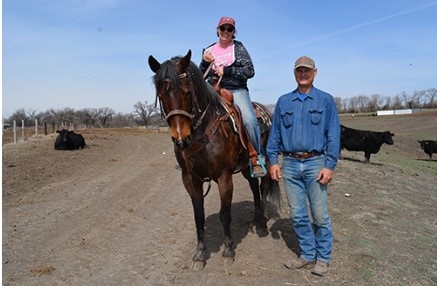WASHINGTON, DC – WHEAT: The outlook for 2021/22 U.S. wheat this month is for reduced supplies, lower domestic use and exports, and decreased ending stocks. Supplies are lowered on reduced wheat production and beginning stocks. All wheat production is lowered 152 million bushels to 1,746 million. The all wheat yield is 45.8 bushels per acre, down 4.9 bushels from last month.
The NASS July Crop Production report provides survey-based production forecasts for all wheat classes for the first time in the 2021/22 crop year. The production forecasts for durum and other spring wheat indicated a significant decline compared to last year for these two classes due to the severe drought conditions affecting the Northern Plains.
 Partially offsetting this decrease is higher winter wheat production, both on increased harvested acreage and a higher yield. Imports are raised 20 million bushels to 145 million.
Partially offsetting this decrease is higher winter wheat production, both on increased harvested acreage and a higher yield. Imports are raised 20 million bushels to 145 million.
Beginning stocks are reduced on the latest NASS Grain Stocks report, which indicated lower
2020/2021 ending stocks than previously estimated.
Projected exports and feed and residual usage are lowered to 875 and 170 million bushels,
respectively, on the reduction in durum and other spring wheat supplies. These would be the
smallest U.S. wheat exports since the 2015/16 marketing year. Projected 2021/22 ending stocks are
reduced 105 million bushels to 665 million and are the lowest since 2013/14. The projected 2021/22
season-average farm price is raised $0.10 per bushel to $6.60.
The global wheat outlook for 2021/22 is for reduced supplies, fractionally lower consumption,
increased trade, and lower ending stocks. Supplies are projected to decline 5.3 million tons to
1,082.6 million on reduced beginning stocks in several countries and lower U.S. production not
offsetting higher foreign production. Global production is lowered 2.0 million tons to 792.4 million but still remains at a record.
Australia’s production is raised 1.5 million tons to 28.5 million, based on continued widespread precipitation benefiting emergence and crop establishment.
Russia’s production is lowered 1.0 million tons to 85.0 million. Winter wheat production is reduced 0.5 million tons to 64.0 million on decreased harvested area from a damaging early spring freeze more than offsetting higher yields on continued favorable conditions across Western Russia. Spring wheat is also lowered 0.5 million tons to 21.0 million on reduced yields with hot and dry conditions affecting the spring wheat region of Central Russia. Kazakhstan is lowered 1.0 million tons to 13.0 million on similar unfavorable conditions.
The EU and United Kingdom are increased a combined 1.4 million tons to 138.2 and 14.8 million, respectively on continued favorable conditions across Northern and Central Europe.
Projected 2021/22 world consumption is fractionally lower at 790.9 million on lower feed and residual use in Russia, the United States, and Kazakhstan mostly being offset by higher food, seed, and industrial use in several countries. Projected 2021/22 global trade is raised 0.8 million tons to a
record 204.0 million, on increased exports by the EU, Ukraine, and Australia offsetting reductions in
Canada, Kazakhstan, and the United States. Projected 2021/22 world ending stocks are lowered 5.1
million tons to 291.7 million but remain above last year.
COARSE GRAINS: This month’s 2021/22 U.S. corn outlook is for larger supplies, greater feed and
residual use, increased exports, and higher ending stocks. Corn beginning stocks are lowered 25
million bushels, based on greater feed and residual use for 2020/21 as indicated in the June 30 Grain
Stocks report. Corn production for 2021/22 is forecast 175 million bushels higher based on greater
WASDE-614-2 planted and harvested area from the June 30 Acreage report. The national average corn yield is unchanged at 179.5 bushels per acre. During June, harvested-area weighted precipitation for the major corn producing states was below normal but did not represent an extreme deviation from the 1988 to 2020 average. For much of the crop the critical pollination period will be during middle and late July and USDA will provide its first survey-based corn yield forecast of the season in the August 12 Crop Production report.
Total U.S. corn use for 2021/22 is forecast 75 million bushels higher with increases for feed and
residual use and exports. Feed and residual use is raised reflecting a larger crop. Corn exports are
raised 50 million bushels, with sharply lower exports expected for Brazil. With supply rising more
than use, ending stocks are up 75 million bushels. The season-average farm price received by
producers is lowered 10 cents to $5.60 per bushel.
This month’s 2021/22 foreign coarse grain outlook is for lower production and use, larger trade, and
smaller stocks relative to last month. Foreign corn production is higher, with a projected increase for
Russia based on higher indicated area. Barley production is raised for Australia but lowered for
Canada, the EU, Russia, Kazakhstan, and India.
For 2020/21, foreign corn production is lowered, with reductions for Brazil and Paraguay more than offsetting an increase for Argentina. Major global trade changes for 2021/22 include larger corn exports for the United States and Russia with a reduction for Mexico. Corn imports are lowered for the EU and Iran. For 2020/21, corn exports are raised for Argentina but lowered for Brazil for the local marketing year beginning March 2021.
Foreign corn ending stocks for 2021/22 are virtually unchanged from last month.
RICE: The outlook for 2021/22 U.S. rice this month is for slightly larger supplies, lower domestic use, higher exports, and larger ending stocks. Supplies are raised slightly as increased beginning stocks
and imports more than offset lower production. Beginning stocks are higher, primarily due to lower
estimates for domestic use and residual for 2020/21, as implied by the latest NASS Rice Stocks
report. Domestic use is also reduced in 2021/22 by 3.0 million cwt to 153.0 million, although still a
record.
All rice production is reduced 2 percent to 199.3 million cwt with all the decline occurring in
medium- and short-grain. The severe drought in California reduced medium- and short-grain area as
reported in NASS Acreage. The all rice yield is also lowered based on less California area, which
consistently achieves higher yields than the southern rice producing States. Because of reduced
supplies of medium- and short-grain, imports for these classes are raised to a record 8.0 million cwt
which increased all rice imports to a record at 39.0 million.
All rice exports are raised 2.0 million cwt to 90.0 million (all long-grain) on expectations the United States will continue its recent expansion of rough rice exports to Venezuela and other Latin American markets. Projected 2021/22 all rice ending stocks are raised by 2.3 million cwt to 41.3 million with long-grain accounting for all the increase. The 2021/22 all rice season-average farm price is increased $0.20 per cwt to $14.40, all on higher medium- and short-grain prices expected for California and Other States.
The 2021/22 global outlook is for reduced supplies, lower consumption, marginally higher trade, and
decreased ending stocks. Supplies are reduced by 2.0 million tons to 681.0 million, primarily on a
combination of lower beginning stocks for India and decreased production for Egypt, EU, and United
States. India’s beginning stocks are reduced as its 2020/21 exports are raised 2.0 million tons to a
record 19.0 million on a continued robust pace and very competitive export prices.
World 2021/22 consumption is reduced by 0.6 million tons to a still record 514.0 million. Global 2021/22 trade is raised 0.1 million tons to 47.1 million, on higher exports by the United States, Brazil, and Australia. Projected 2021/22 world ending stocks are reduced by 1.4 million tons to 167.0 million, primarily on India as its stocks are at a 4-year low.
OILSEEDS: U.S. oilseed production for 2021/22 is projected at 130.5 million tons, up 0.2 million
from last month, with increases for sunflowerseed, peanuts, and cottonseed partly offset with a
reduction for canola. Soybean production is projected at 4.4 billion bushels, unchanged from last
month. Harvested area, forecast at 86.7 million acres in the June 30 Acreage report, is unchanged
WASDE-614-3 from last month but up 4.4 million from last year. The soybean yield forecast is unchanged at 50.8 bushels per acre. Soybean supply and use forecasts are unchanged from last month.
Soybean changes for 2020/21 include lower imports, crush, and exports. With offsetting changes in
supply and use, ending stocks are unchanged at 135 million bushels. The U.S. season-average
soybean price for 2020/21 is forecast at $11.05 per bushel, down $0.20 as early-season sales at
lower prices continue to weigh on the season-average forecast. The soybean meal price is projected
at $395.00 per short ton, down $10.00 from last month. The soybean oil price is forecast at 57.5
cents per pound, down 1.5 cents.
The 2021/22 global oilseed supply and demand forecasts include higher production, exports, crush,
and ending stocks compared to last month. Global oilseed production is raised 2.5 million tons to
635.4 million, with higher sunflowerseed, rapeseed, cottonseed, and peanuts partly offset by lower
soybean output.
Russian sunflowerseed production is increased 2.0 million tons to 16.5 million, mainly on higher area shown in government planting progress reports. Australian rapeseed production is raised on beneficial early-season rainfall and higher area. Canadian canola production is lowered as early-season drought conditions impact yields and offset an increase to area. Canada’s soybean production is also lowered based on lower area.
The 2021/22 global soybean ending stocks are increased 1.9 million tons to 94.5 million as higher
stocks for Brazil and Argentina are partly offset by lower Chinese stocks. The stocks revisions reflect
notable balance sheet changes for Brazil and Argentina in 2020/21 and China in 2020/21 and
2021/22. Exports for Brazil and Argentina for 2020/21 are reduced as high prices lead to lower
shipments to China. China’s imports are reduced 2 million tons to 98 million and 1 million tons to 102 million for 2020/21 and 2021/22, respectively.
Another notable oilseed change includes a 0.3-millionton reduction to 18.2 million for Malaysian 2020/21 palm oil production.
SUGAR: High-tier tariff sugar imports for 2019/20 and 2020/21 have been corrected due to a
discovery of errors in the labelling of data maintained by the U.S. Bureau of the Census (CENSUS).
The CENSUS data, which USDA uses to identify high-tier tariff imports, were correct through the
month of June 2020 but have been incorrect since July 2020.
With the assistance of USDA, CENSUS staff have identified the problem and are in the process of correcting the data. Revised import estimates will be published as soon as practicable. In the meantime, USDA is using nonpublic estimates of high-tier tariff imports as compiled by U.S. Customs and Border Protection in their ACE database. These data since July 2020 through May 2021 will be published by FAS shortly after the release of the July 2021 WASDE. Sweetener Market Data (SMD) for imports and deliveries by non-reporters are revised for both 2019/20 and 2020/21.
Imports for 2019/20 are decreased by 92,042 short tons, raw value (STRV) to 4.143 million. Deliveries for human consumption for 2019/20 are reduced by the same amount to 12.224 million STRV. Although there is no change to SMD survey-based ending stocks, the ending stocks-to-use ratio for 2019/20 is increased by 0.1 percentage points to 13.0 percent because of lower use.
U.S. sugar production for 2021/22 is decreased by 302,422 STRV to 9.008 million. Beet sugar
production is projected lower by 192,422 STRV due to a reduction from last month of projected yield
in the Upper Midwest on processors’ reporting and a lower U.S. area harvested forecast in the NASS
Acreage report.
Florida cane sugar is decreased by 85,000 STRV on processors’ reporting of a reduction from last month in forecast area harvested. Louisiana cane sugar production is decreased by 25,000 on lower sugarcane yields forecast by processors. Beet sugar production for 2020/21 is decreased slightly by lower estimated recovery only partially offset by an increase in estimated sugarbeet production in California. The Florida 2020/21 campaign ran late through the beginning of June and is estimated at 2.091 million STRV. The length of the campaign contributed to reduced area for the succeeding campaign in 2021/22.
Imports for 2020/21 are increased by 34,093 STRV to 3.138 million STRV. TRQ imports for 2020/21
are estimated at 1.778 million STRV on the basis of the 44,093 STRV increase in the additional
specialty TRQ and an additional 60,000 STRV of raw sugar expected to enter after the reallocation
by USTR of the raw sugar TRQ shortfall. Shortfall is now estimated at 86,854 STRV, down from
146,854 last month.
Partially offsetting these increases are pace-to-date reductions to re-export imports (50,000 STRV reduction) and high-tier tariff sugar imports resulting from ACE sourcing (20,000 STRV reduction). Imports for 2021/22 are increased by 484,000 STRV due to an expected increase in imports from Mexico.
There are no changes to use for either 2020/21 or 2021/22. Even with downward revisions made for
2020/21 direct consumption imports due to lower high-tier tariff sugar imports, the pace of overall
deliveries appears consistent with an unchanged 12.125 million STRV. Deliveries for 2021/22 are
still expected to be flat. All changes for 2020/21 imply an additional 21,522 STRV in ending stocks
for a stocks-to-use ratio of 14.49 percent. Ending stocks for 2021/22 are projected at 1.656 million
STRV for a stocks-to-use ratio of 13.50 percent.
Mexico production for 2020/21 is estimated at 5.708 million metric tons (MT). The campaign is nearly over with only one mill in operation as of July 3. The projection for 2021/22 production is unchanged at 5.809 million MT.
Deliveries for IMMEX for 2020/21 are increased by 13,000 MT to 428,000 on the pace to date and the projection for 2021/22 is correspondingly increased by the same amount.
Required ending stocks to meet delivery needs for the 2.5 months before the start of the 2021/22
sugarcane campaign are increased slightly because of the 2021/22 increase for IMMEX. These
small changes imply slightly lower exports for both 2020/21 and 2021/22. Exports to the United
States for 2021/22 are increased to 1.240 million MT on calculated U.S. Needs implied by the July
2021 WASDE as set out in the AD/CVD Suspension Agreements. Residually determined exports to
other destinations are projected at 271,088 MT.
LIVESTOCK, POULTRY, AND DAIRY: The forecast for 2021 red meat and poultry production is
lowered from last month on lower pork, broiler, and turkey forecasts.
The beef production forecast is unchanged as higher slaughter is offset by lower expected carcass weights. Pork production is reduced on lower expected second-half commercial hog slaughter.
Broiler and turkey production are lowered on the pace of production in the second quarter. However, the forecasts for the remainder of the year are unchanged. The egg production forecast is lowered from last month on recent production and flock data.
For 2022, the red meat and poultry production forecast is lowered, primarily on lower pork production as well as slightly lower beef production.
USDA’s Quarterly Hogs and Pigs report indicated producers expect to farrow fewer sows in the second half of 2021 which, when coupled with slower forecast growth in pigs per litter, will tighten supplies of market-ready hogs in 2022 relative to last month.
USDA will release the Cattle report on July 23, which will provide an indication of the midyear inventory and producer intentions for heifer retention.
Broiler, turkey, and egg forecasts are unchanged from last month.
Beef import forecasts for 2021 and 2022 are unchanged from last month while the export forecasts
are raised for both years on continued firm demand in Asia. Pork import and export forecasts for
2021 and 2022 are unchanged. Broiler exports for 2021 are raised primarily on higher-than-expected
May data, but no change is made to the forecasts for 2022. The turkey export forecast is raised
slightly for 2021 on current trade data; the forecast for 2022 is unchanged.
Cattle price forecasts for 2021 are raised on the strength of recent prices; no change is made to the
annual 2022 price. The 2021 hog price forecast is reduced on current price weakness, but the price
forecast for 2022 is unchanged as tighter supplies during the year, relative to last month, are
expected to help support prices. The broiler price forecast for 2021 is raised on slightly higher
expected third-quarter prices; no change is made to the 2022 broiler price. Turkey price forecasts for
WASDE-614-5 2021 and 2022 are raised on improving demand. The 2021 and 2022 egg price forecasts are reduced on current price weakness.
Milk production forecast for 2021 is lowered from last month as slower-expected growth in milk per
cow more than offsets higher forecast cow numbers. However, the 2022 milk production forecast is
raised from last month on higher cow numbers. USDA’s Cattle report, to be released on July 23rd,
will provide a mid-year estimate of the dairy cow inventory and producer intentions regarding
retention of heifers for dairy cow replacement.
Imports on both fat and skim-solids bases are raised for 2021 and 2022 on stronger expected imports
of cheese and butterfat containing products. Exports on a skim-solids basis are also raised for 2021
and 2022, reflecting stronger exports of whey, skim/nonfat dry milk powder, and lactose. Fat basis
exports are unchanged from last month.
For 2021, cheese, butter, nonfat dry milk (NDM), and whey price forecasts are lowered from last
month on relatively high stocks and weaker-than-previously-expected demand. As a result, Class III
and Class IV prices are lowered.
The 2021 all milk price forecast is lowered to $18.30 per cwt. For 2022, price forecasts for cheese and butter are lowered on larger expected stocks and higher production, but price forecasts for NDM and whey are unchanged. With lower cheese and butter prices, Class III and Class IV price forecasts are reduced and the 2022 all milk price forecast is lowered to $18.50 per cwt.
COTTON: The U.S. 2021/22 cotton projections show higher production, exports, and ending stocks
compared with last month. While the June 30 Acreage report shows 300,000 fewer planted acres for
U.S. cotton than NASS’s previous survey, a rainfall-driven reduction in projected Texas abandonment
means U.S. harvested area is projected 9 percent higher. While 2021/22 production is 800,000 bales
higher, consumption is unchanged, and exports and ending stocks are each projected 400,000 bales
higher.
The upland cotton farm price for 2021/22 is unchanged, at 75 cents per pound, while the
2020/21 price is reduced one half cent to 66.5 cents per pound.
World 2021/22 ending stocks of cotton are projected 1.6 million bales lower than in June as largely
offsetting changes in production and consumption do little to offset lower estimated beginning stocks. Beginning stocks are 1.5 million bales lower, largely due to reduced 2020/21 Brazilian and Indian
production and higher Indian consumption.
World production in 2021/22 is projected about 500,000 bales higher this month as a larger U.S. crop more than offsets a 300,000-bale decline for Pakistan. Consumption is slightly more than 600,000 bales higher largely due to an increase for India.
World trade is projected 670,000 bales lower, with China’s imports 1 million lower and Brazil’s exports 1.1 million bales lower












